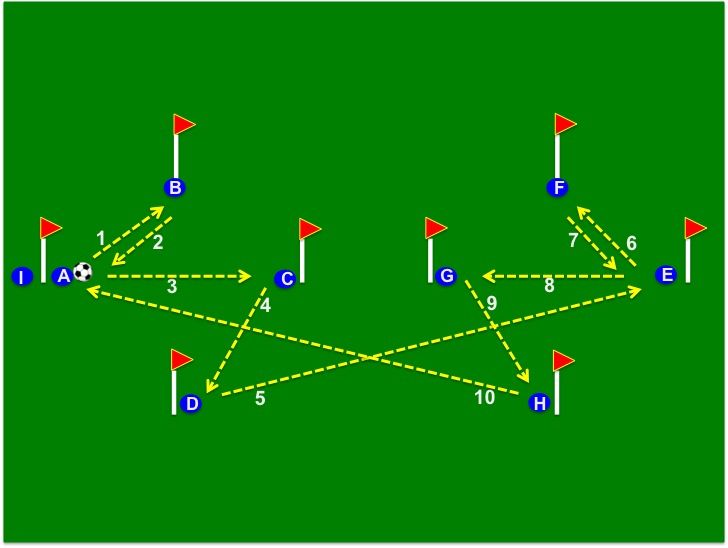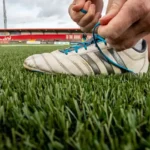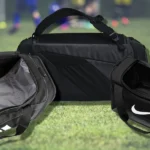Spain’s golden era of football wasn’t just about trophies—it was built on one of the most mesmerizing systems the game has seen: tiki-taka. The short, fast-paced passes, spatial awareness, and constant off-the-ball movement gave Spain dominance over world football. But how did they train for such fluency? In this blog, you’ll learn five game-tested tiki-taka passing drills designed to improve your team’s tempo, precision, and rhythm—just like Spain at their peak.
Whether you’re a coach, player, or football enthusiast, these drills will help sharpen quick thinking, tight control, and intelligent movement. Let’s get right into the drills that shaped a football dynasty.
Drill 1: Rondo 5v2 – The Foundation of Tiki-Taka
Purpose:
Develop quick decision-making, ball control in tight spaces, and pressing resistance.
Setup:
- Players: 7 total (5 attackers, 2 defenders)
- Area: 10×10 meters
- Form a circle with 5 attackers on the outside and 2 defenders in the middle.
Instructions:
Attackers pass the ball quickly, aiming to avoid the defenders. One-touch or two-touch maximum. If a defender wins the ball or the ball goes out, the last player who lost it switches roles.
Key Coaching Points:
- Constant movement by attackers to create angles.
- Head up before receiving the ball.
- Communicate and use dummy movements.
Why It Works:
This drill mirrors match situations where players must operate in tight quarters with minimal time. It’s used daily by elite academies like La Masia and reflects the heart of the tiki-taka passing drills system.
Variation:
Increase the number of defenders or reduce touches to add pressure.
Drill 2: One-Touch Triangle Passing
Purpose:
Encourage one-touch play, spatial recognition, and support positioning.
Setup:
- Players: 3 per group
- Area: 5×5 meters triangle
Instructions:
Players stand at each corner of a triangle. Ball circulates with one-touch passes. After passing, players rotate clockwise to the next cone.
Key Coaching Points:
- Keep passes crisp and accurate.
- Rotate at full speed to mimic match movement.
- Support the next pass with good body positioning.
Why It Works:
This drill instills muscle memory for quick, accurate passing while promoting awareness. Players also develop timing and positioning—key traits of Spain’s iconic system.
Progression:
Use two balls simultaneously or introduce a defender to apply pressure.
Drill 3: Four-Goal Passing Box
Purpose:
Improve directional passing, decision-making, and transition awareness.
Setup:
- Players: 6 to 10
- Area: 20×20 meters square with mini goals on each side
Instructions:
Two teams compete to complete passes and score in any of the four mini goals. Ball must go through at least three players before a goal attempt.
Key Coaching Points:
- Keep the ball moving with one or two touches.
- Switch play to find open goals.
- Stay compact defensively, then expand when in possession.
Why It Works:
Unlike static drills, this simulates live match dynamics. Players learn to think under pressure, switch directions fluidly, and maintain possession—all of which align perfectly with tiki-taka passing drills philosophy.
Drill 4: Two-Zone Possession Grid
Purpose:
Enhance positional awareness, off-the-ball movement, and split-second passing.
Setup:
- Players: 8 to 12
- Area: 20×10 meters, divided into two equal zones
- Teams: 4v2 in each zone (or adjust based on numbers)
Instructions:
Start with a 4v2 possession in one zone. After 5 completed passes, the ball must be played into the second zone. When the ball transitions, two players from the attacking team move to support the new zone. The defending team must send two players to press immediately.
Key Coaching Points:
- Quick transition after passing to new zone.
- Maintain triangle or diamond shapes at all times.
- Communicate movement and keep eyes on the switch.
Why It Works:
This drill captures the flow of a real match, especially during transitions. The switch of play mimics how Spain pulls opponents wide and then exploits gaps. It’s highly effective for building spatial control, patience, and quick releases—the backbone of any tiki-taka passing drills session.
Progression:
Limit touches to one-touch only, or introduce neutral players who always support the team in possession.
Drill 5: Central Diamond Drill
Purpose:
Improve ball circulation through the middle, develop pivots, and create layers of passing angles.
Setup:
- Players: 6 to 8
- Area: 15×15 meters square with a diamond shape in the center
- Cones form a central diamond; four players occupy it, others on outside stations.
Instructions:
The ball starts with an outside player. The goal is to pass into the diamond and out to another side—quickly, without losing momentum. Rotate players after every few minutes.
Key Coaching Points:
- Interior players must open up and be available constantly.
- Body shape should allow for seamless turning and passing.
- Quick wall passes and communication are key.
Why It Works:
Spain’s midfield revolved around fast tempo in central areas. This drill trains players to dominate the middle, use short angles, and combine in tight areas under pressure—all essential for mastering tiki-taka passing drills.
Variation:
Add a passive or active defender in the center to force quicker decisions.
Pros & Cons of Tiki-Taka Passing Drills
Pros:
- Builds fast decision-making under pressure.
- Sharpens player chemistry and movement.
- Promotes ball retention and mental sharpness.
- Improves awareness in small spaces.
Cons:
- May not suit teams with limited technical ability.
- Requires high concentration and discipline.
- Can lead to over-passing if not balanced with direct play.
FAQs
What is tiki-taka in football?
It’s a possession-based style of play characterized by quick short passes, constant movement, and positional play. It was perfected by Spain and FC Barcelona.
Why use tiki-taka passing drills in training?
These drills train players to move intelligently, pass quickly, and maintain control in any phase of the game, improving performance and ball confidence.
Where can I implement these drills?
These drills can be run at amateur clubs, youth academies, school teams, or even during one-on-one sessions with adaptations.
Who should use these drills?
Ideal for teams that prioritize control, technique, and tactical movement over raw physicality.
Will these drills help my team score more?
Yes, indirectly. They help maintain possession, open up defenses, and create more scoring chances through intelligent build-up.










